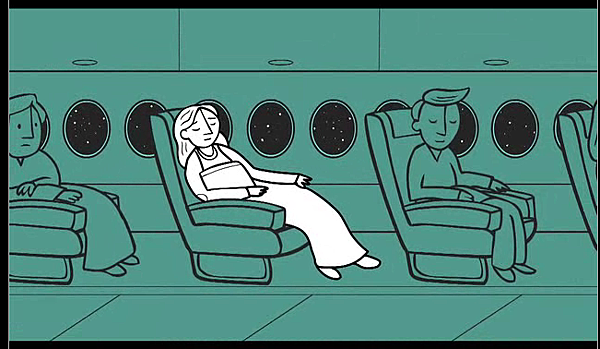
Commercial airlines serve approximately 2.75 billion passengers worldwide annually. When in-flight medical emergencies occur, access to care is limited. Physicians and other medical professionals are often called on to assist when traveling, despite limited training or experience with these situations.1 Airlines partner with health care institutions to deliver real-time medical advice from an emergency call center to airline personnel, in an effort to improve the quality of care provided to passengers.
There is limited information on the incidence and characteristics of in-flight medical emergencies.2 Although previous studies of these events have characterized the incidence, categories of symptoms, rates of aircraft diversion, and resources accessed, many have used information obtained from single airlines and have lacked information on patient outcomes.1,3-9
We conducted a study of in-flight medical emergencies involving large commercial airlines, characterizing on-board assistance provided by flight crews and other passengers and identifying the outcomes of these events, including ambulance transport to a hospital and hospital admission. On the basis of our findings, we suggest a practical approach to the initial management of common in-flight medical emergencies for medical personnel who may be called on to render aid.
METHODS
Data Collection
We reviewed records of all calls to a medical communications center from five domestic and international airlines that represented approximately 10% of the global passenger flight volume from January 1, 2008, through October 31, 2010. The communications center provides medical consultations with the use of radio or satellite telephone communications. It is located at an academic medical center and is staffed by emergency physicians who are trained in telemedicine and the management of in-flight medical emergencies.
A narrative summary of each event is recorded, and categorical data are entered into an electronic database (Excel 2007, Microsoft). Data include medical problem, flight origin and destination, flight phase (i.e., airplane at terminal, taxiing, in flight, or landing), availability of on-board assistance, and use of medications or medical equipment. In cases in which more than one passenger renders medical assistance, the person with the highest level of training is recorded. After each event, communications-center personnel determine whether or not the patient was taken to a hospital and the disposition from the emergency department. Outcome variables collected include whether or not the aircraft was diverted from its intended destination, whether or not the passenger was transported to a hospital, and, if transported, the passenger's disposition from the emergency department. We excluded events that did not occur in flight, such as during preflight gate screenings or on-board emergencies occurring before takeoff or after landing.
The first two authors reviewed the most common primary symptoms in the electronic database and created medical categories according to body system, nature of illness, or both (Table 1
).
For example, we categorized loss of consciousness, “blacking out,” or feeling lightheaded as syncope or presyncope. Similarly, we categorized chest pain, palpitations, or pacemaker concerns as cardiac symptoms. Cardiac arrest was in a separate category. All events categorized as “other” were individually of low incidence. Our abstractor used a standardized form, referring cases of uncertain classification to the first two authors to resolve by consensus.
We used the recorded origin and scheduled destination of each flight to determine flight distance and whether it was domestic (within the United States) or international. To determine the overall number of passengers during our study period, we obtained statistics from the U.S. Department of Transportation,10 supplemented by personal communication with the airlines. We determined whether an automated external defibrillator (AED) was used and collected data on clinical factors (loss of consciousness, loss of pulses, shock delivery, and return of pulses) through a review of narrative records of these cases. The University of Pittsburgh institutional review board approved the study and waived the requirement for informed consent. The second author vouches for the completeness and accuracy of the data.
Statistical Analysis
We determined the frequency of each medical-problem category, aircraft type, AED use, availability of on-board medical assistance, airline, and flight distance. We report descriptive data (means ±SD) for continuous variables and percentages for categorical variables. We performed a univariable analysis of the association between the factors above and specific patient outcomes, using a two-sample t-test for the continuous variable of age and chi-square tests for categorical variables. Next, we performed a multivariable analysis, using logistic regression to identify factors associated with specific outcomes while controlling for other factors that were found to have an association in the univariable analysis (Table 2
).
All reported P values are two-sided; a P value of less than 0.05 was considered to indicate statistical significance. We used SPSS software, version 19.0 (IBM), for the analyses.
RESULTS
Characteristics of Medical Emergencies and Outcomes
The communications center received calls about 11,920 in-flight medical emergencies among an estimated 744 million airline passengers during the study period, for a rate of 16 medical emergencies per 1 million passengers. There were 7,198,118 flights by the included airlines during the study period, for an incidence of 1 in-flight medical emergency per 604 flights. The age of the passengers with in-flight emergencies ranged from 14 days to 100 years (mean, 48±21 years). The most common medical problems were syncope or presyncope (37.4%), respiratory symptoms (12.1%), and nausea or vomiting (9.5%) (Table 1), with some variation across airlines (see Table S1 in the Supplementary Appendix, available with the full text of this article at NEJM.org). Aircraft diversion occurred in 875 of 11,920 cases (7.3%); the remaining flights landed at their scheduled destinations.
Postflight follow-up data were available for 10,914 passengers with in-flight medical emergencies (91.6%) (Figure 1
).
For 3402 passengers (31.2%), the situation resolved sufficiently before landing so that emergency-medical-service (EMS) personnel were not requested. Of the 7508 patients for whom EMS personnel were requested to meet the aircraft on landing, 2804 (37.3%) were transported to a hospital emergency department. Subsequently, 901 patients (8.6% of those for whom follow-up data were available) were admitted to the hospital or left the emergency department against medical advice. In addition to cardiac arrest, medical problems that were associated with the highest rates of hospital admission were strokelike symptoms (23.5%), obstetrical or gynecologic symptoms (23.4%), and cardiac symptoms (21.0%). Of the 36 deaths identified, 30 occurred during flight. The mean age of passengers who died was 59±21 years (range, 1 month to 92 years).
Of the 61 cases of obstetrical or gynecologic symptoms in our study, most (60.7%) occurred in pregnant women at less than 24 weeks of gestation with signs of possible miscarriage (e.g., vaginal bleeding), including 7 of 11 obstetrical or gynecologic cases resulting in diversion. Eleven cases (18.0%) involved women in labor beyond 24 weeks, of which 3 cases resulted in diversion.
Providers of On-Board Medical Assistance
On-board assistance was provided by physicians (48.1%), nurses (20.1%), EMS providers (4.4%), or other health care professionals (3.7%). Aircraft-diversion and hospitalization rates differed according to the type of medical volunteer. Diversion rates according to provider (from highest to lowest) were as follows: physicians, 9.4% (95% confidence interval [CI], 8.7 to 10.2); EMS providers, 9.3% (95% CI, 6.8 to 11.7); nurses, 6.2% (95% CI, 5.2 to 7.2); and flight crew only, 3.8% (95% CI, 3.1 to 4.5). Hospitalization rates according to provider were as follows: EMS providers, 10.2% (95% CI, 7.5 to 12.9); physicians, 9.3% (95% CI, 8.5 to 10.0); nurses, 8.7% (95% CI, 7.5 to 9.8); and flight crew only, 4.7% (95% CI, 3.9 to 5.6). In the multivariable analysis, the factors that had the strongest association with aircraft diversion were AED use and on-board assistance by an EMS provider as the highest-level provider (Table 2). Hospital admission was associated with possible stroke, respiratory symptoms, and cardiac symptoms.
Medication Administration
Medications administered during in-flight medical emergencies are listed in Table S2 in theSupplementary Appendix. Most medications that were used are available in the Federal Aviation Administration (FAA)–mandated emergency medical kit,11 which may be supplemented by individual airlines (Table S3 in the Supplementary Appendix). Some medications that were administered came from other passengers or the patients themselves. The most commonly used medications and medical therapies were oxygen (in 49.9% of cases), intravenous 0.9% saline solution (in 5.2%), and aspirin (in 5.0%). Among 1136 passengers with an in-flight emergency related to nausea or vomiting and documentation of whether an antiemetic agent was used, 1 of 109 (0.9%) who received an antiemetic agent had an event that resulted in aircraft diversion versus 55 of 1027 (5.4%) who did not receive an antiemetic (P=0.04). Diversion rates did not differ significantly according to whether albuterol was used for respiratory symptoms or whether nitroglycerin was used for cardiac symptoms.
AED Use
An AED was applied to 137 patients with an in-flight medical emergency (1.3%). Among 134 patients (97.8%) for whom narrative records were available, the chief symptoms were syncope or presyncope (41.0%) and chest pain (23.9%); 84 patients (62.7%) had a loss of consciousness. An AED was applied in 24 cases of cardiac arrest. A shock was delivered in 5 cases. A return of spontaneous circulation occurred in 1 patient receiving defibrillation and 8 other patients when an AED was used but no shock was indicated. All but 1 patient with a return of spontaneous circulation survived long enough to be admitted to a hospital.
DISCUSSION
On the basis of our data, we estimate that 44,000 in-flight medical emergencies occur worldwide each year. Medical emergencies during commercial airline travel, although rare when considered on a per-passenger basis, occur daily; traveling physicians and other health care providers are often called on to aid ill passengers. A basic knowledge of in-flight medical emergencies and awareness of the resources available can help them be effective volunteers. The emergency medical kit available on every commercial airliner regulated by the FAA is usually sufficient to initiate treatment for serious problems. Many airlines have an enhanced emergency medical kit, increasing treatment options (Table S3 in the Supplementary Appendix). Most in-flight medical emergencies are self-limiting or are effectively evaluated and treated without disruption of the planned route of flight. Serious illness is infrequent, and death is rare.
Although the FAA does not require consultation with a physician on the ground in the case of an in-flight emergency, airlines partner with specific health care delivery groups to provide consistent availability of medical expertise. Consulting physicians on the ground are able to communicate directly with flight crew members and on-board health care volunteers or through efficient relay processes involving the pilot. In our experience, passengers' symptoms can often be managed in collaboration with the flight attendants, who are well versed in the equipment that the airplanes carry and in operational procedures. When the need for evaluation or intervention exceeds their capabilities, flight attendants may seek health care professionals on the flight. Many airlines require consultation with a ground-based physician before the emergency medical kit is used. A collaborative approach to management of the medical problem should ensue. The health care provider in flight can make direct observations, and the consulting ground-based physician has familiarity with the environment, the available medical resources, knowledge of passenger health issues, and awareness of airline operational concerns. As a team, they provide the best possible care, given the constraints.
The risk of medical liability may be a concern for volunteer health care providers. The 1998 Aviation Medical Assistance Act includes a Good Samaritan provision,12 protecting passengers who offer medical assistance from liability, other than liability for gross negligence or willful misconduct.13 Although there is no legal obligation to intervene, we believe that physicians and other health care providers have a moral and professional obligation to act as Good Samaritans.
We suggest an algorithm for approaching the more common in-flight medical emergencies on the basis of our findings (Table 3
).
In our study, syncope, respiratory symptoms, nausea or vomiting, and cardiac symptoms were the most common in-flight emergencies, findings that are consistent with the results of prior studies.14,15 Although patients with syncope are often unresponsive and may initially have hypotension, in most cases, improvement occurs within 15 to 20 minutes, and further treatment is usually not required, other than oral or intravenous fluids. The partial pressure of oxygen is lower in a pressurized aircraft than at sea level, and supplemental oxygen can be helpful. Persistently altered mental status or factors that raise concern about time-sensitive conditions, such as myocardial infarction or stroke, should prompt consideration of landing the aircraft.
Potential cardiac symptoms account for a relatively large number of in-flight medical emergencies. Most can be managed with simple treatment after a focused history taking, until definitive care is available. Aspirin, nitrates, and oxygen are available in the emergency medical kit. Patients with angina or atypical chest pain can be treated and transferred to an ambulance on landing. In cases in which myocardial infarction or acute dysrhythmia is suspected, monitoring with an AED may aid in diagnosis and decisions about disposition. Serious nonarrest cardiac events resulting in hospital admission are rare; of the 920 nonarrest cardiac cases, none resulted in death.
Obstetrical symptoms were rare causes of in-flight medical emergencies, a finding that supportsexisting recommendations that air travel is safe up to the 36th week of gestation. 16 The majority of cases of obstetrical or gynecologic symptoms (60.7%) occurred in pregnant women at less than 24 weeks of gestation. Only three cases involving pregnant women in labor beyond 24 weeks resulted in diversion.
In-flight cardiac arrest can be managed with an AED and epinephrine, which is stocked in the emergency medical kit. The rate of survival after cardiac arrest on a commercial airliner ranges from 14 to 55%, with the higher rates among patients with ventricular fibrillation.17,18 We found that in 42.1% of cases of cardiac arrest, the flight was not diverted. These cases included arrests that occurred at a time when immediate diversion was not feasible (e.g., while the airplane was crossing the ocean), and arrests that occurred when the airplane was close to the intended destination and diversion would not have been beneficial to the patient. The death rate among all patients with in-flight medical emergencies was 0.3%, which is consistent with previously reported rates of 0.3 to 1.3%.1-3,9
Common challenges to providing medical care aboard an aircraft include limited space and equipment. In unfamiliar settings, physicians and others may rely on what they know best, including making specific diagnoses on the basis of their areas of expertise. Physicians and other health care providers may be called on by the crew for more serious cases, which may help explain the higher rates of diversion and hospitalization when health care professionals provide on-board assistance.
Diversion of a commercial airliner to an unscheduled destination for an ill passenger requires consideration of both medical and operational issues. The potential medical benefit should be assessed on the basis of the condition and its time sensitivity, the ability to stabilize the patient's condition with available supplies, and the likely time savings with consideration of the time needed to land and the proximity of medical resources to specific airports. Immediate operational factors that may contribute to variability in airline practices include weather, fuel load and the potential need to drop fuel before landing, the availability of specific aircraft services at airports, and air-traffic control.
Our study is limited by its retrospective nature, with only in-flight medical emergencies that prompted calls to our communications center included in the analysis. Although all flight crews are instructed to use this consultation service for any in-flight medical emergency, there are events that occur without notification of the communications center. The medical categories we used were based on descriptions of the passenger's primary symptom, not on diagnoses. The data obtained as part of these consultations were limited by the use of radio or satellite-telephone transmission, communications among multiple people, and the collection of follow-up data from facilities located across the world. Follow-up data were not available for one airline, although the medical problems encountered by that airline were similar to the problems encountered by the other airlines. Differences among airlines in the likelihood of diversion, EMS transport, and hospital admission warrant further study.
On the basis of our findings, we believe that airline passengers who are health care professionals should be aware of their potential role as volunteer responders to in-flight medical emergencies. We also advocate for systematic tracking of all in-flight medical emergencies, including subsequent hospital care and other outcomes, to better guide interventions in this sequestered population.


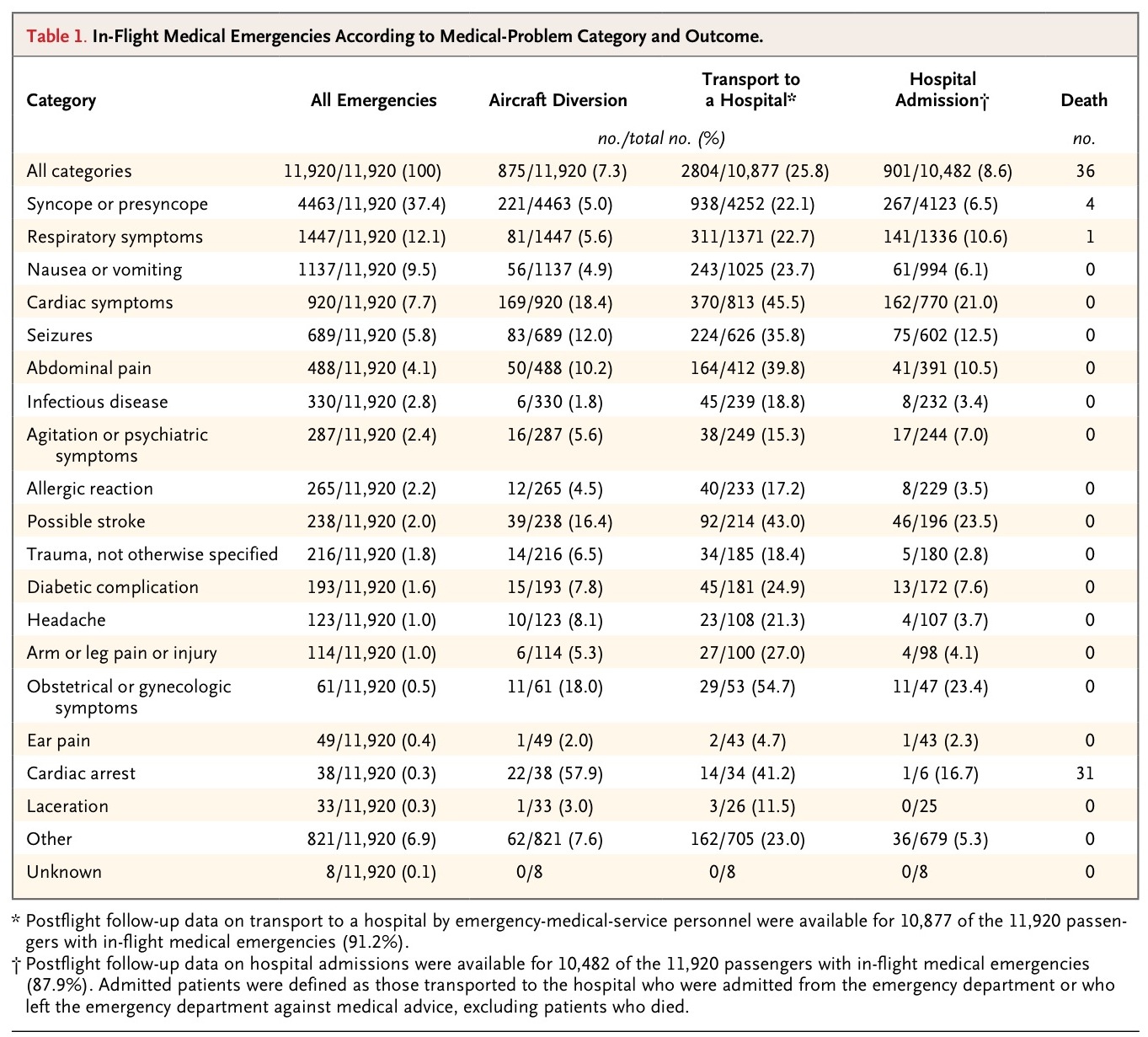
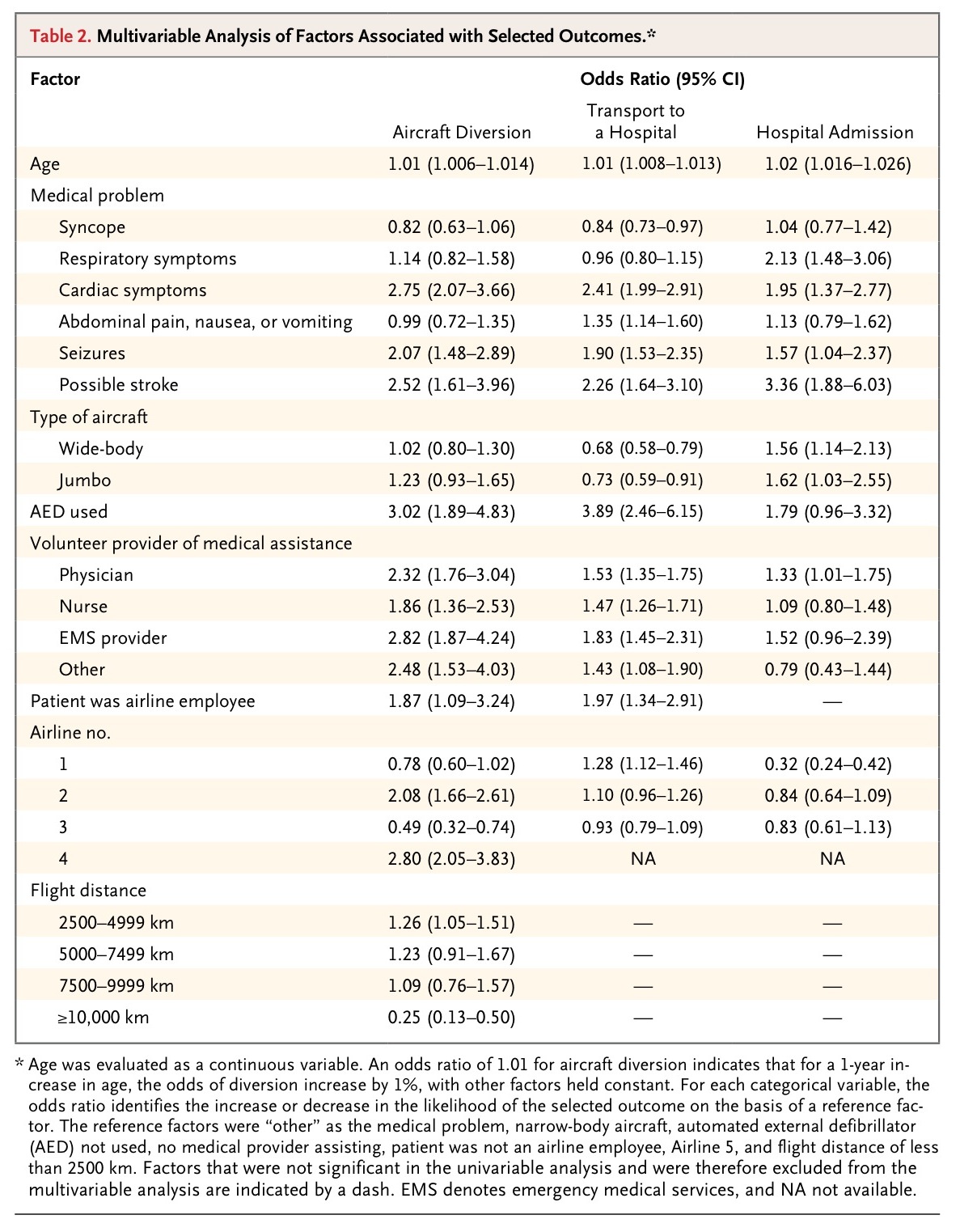
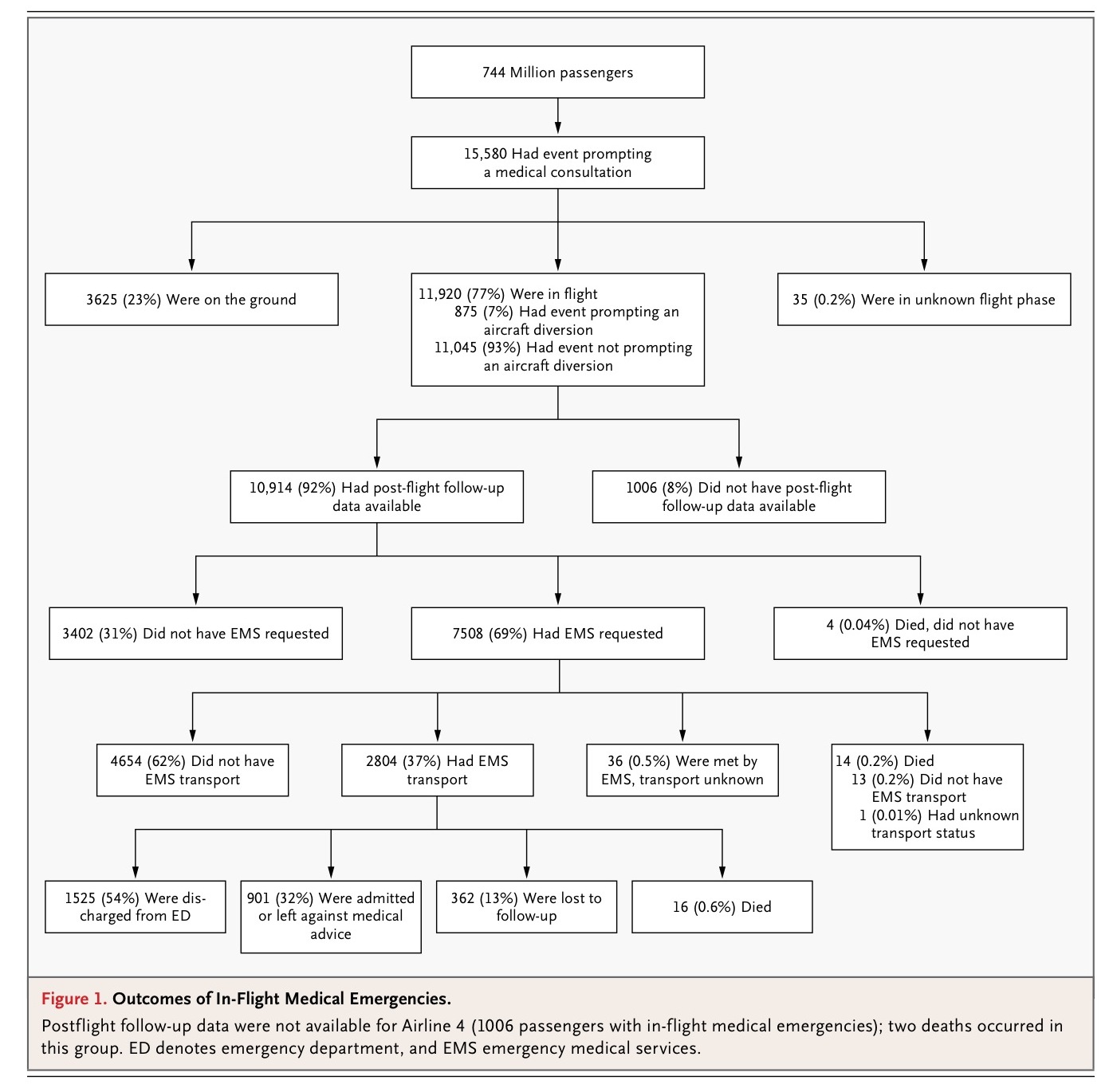
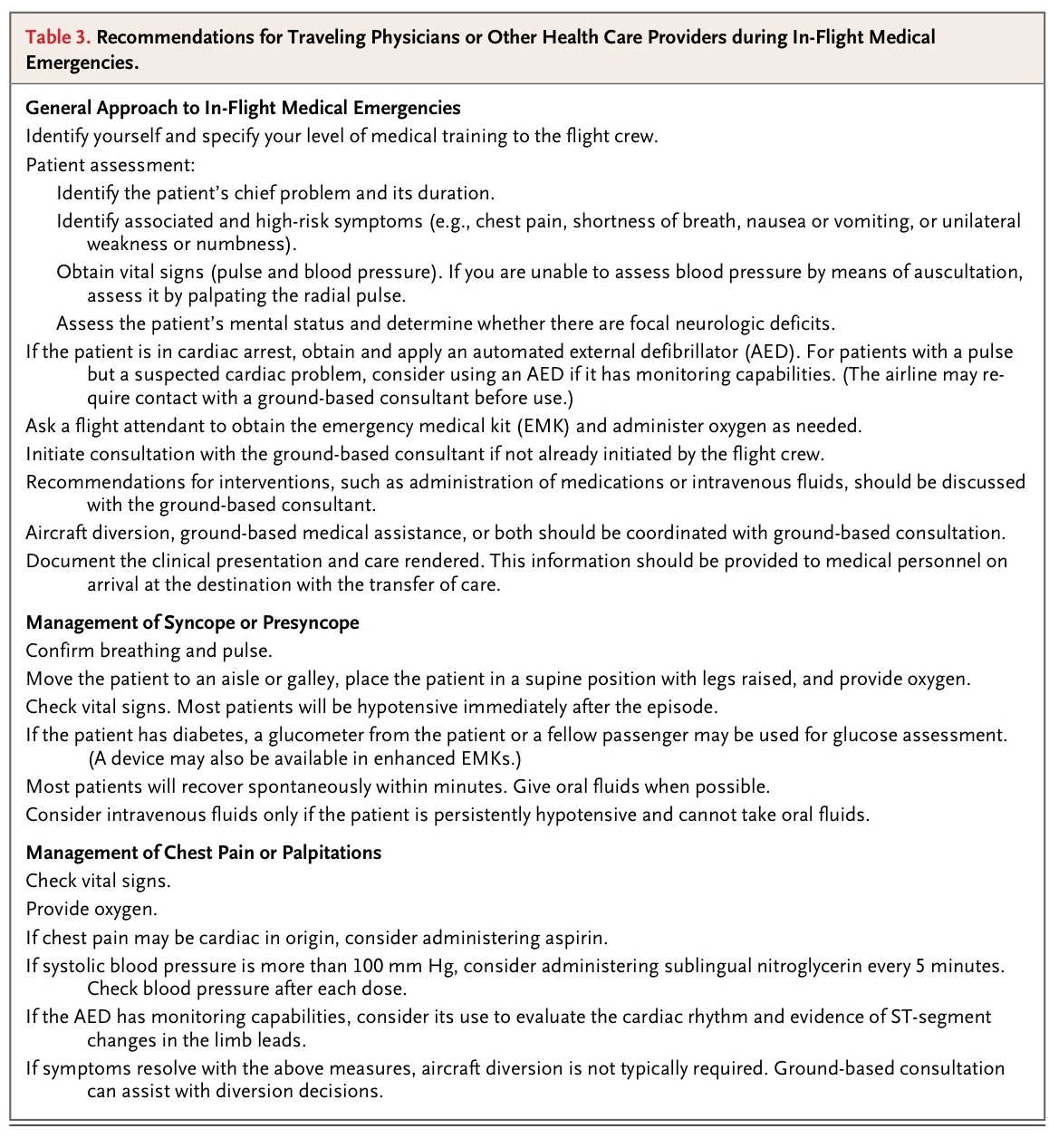



 留言列表
留言列表
 線上藥物查詢
線上藥物查詢 